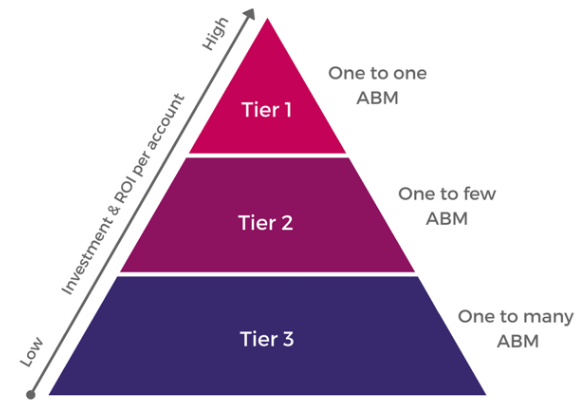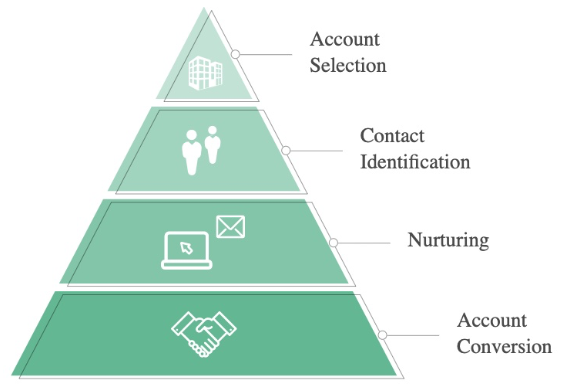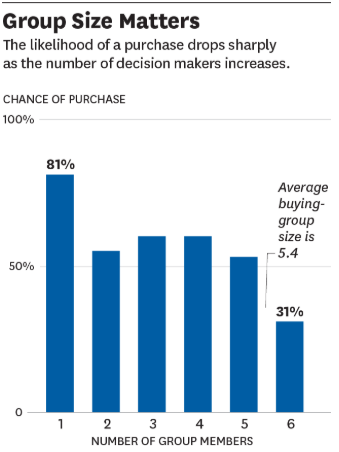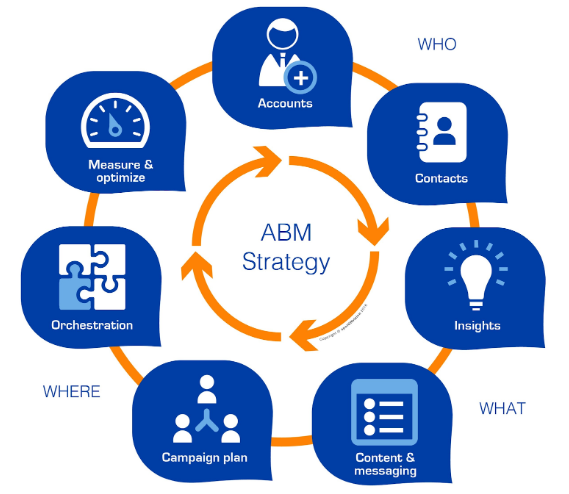Content Marketing and Customer Experience Consultant
What is ABM and why B2B companies could benefit from it?
Content Marketing and Customer Experience Consultant
With the changes brought on by the pandemic, many companies that serve a professional clientele (B2B) are currently undergoing a complete upheaval as a result of their more traditional customer acquisition methods. The health crisis has led to the cancellation of the vast majority of trade shows worldwide, and traditional roadshows were eliminated practically overnight as a possible lever for business development.
The consequences are dire when you realize that these methods have historically represented the main channels for conversion for the vast majority of B2B companies. In addition, the endless demo meetings and negotiations between sales peoples and prospects have now been compromised; meetings are held at a distance, or people don’t see each other at all. It’s far harder to sell anything to anyone when the friendly business meeting gets shelved. B2B companies need to reinvent their sales force, and they need to do it in the midst of a complicated climate that’s changing practically daily depending on emerging health news, and they need to do it all with acquisition budgets that can generally be expected to shrink. Going forward, quality needs to trump quantity, or rather abundance, which has become a rare commodity. Moreover, digital transformation is no longer optional, the timid “go/no-go” no longer makes sense: it’s becoming a near-absolute necessity to survive in business.
One solution resides in an account-based selling approach, or ABM for Account-based Marketing.
What is ABM?
At the heart of the new sales and marketing methods making use of the potential of digital tools, Account-based Marketing is a B2B sales and marketing strategy that’s 100% personalized for each prospect.
Every acquisition campaign focuses on one high value target account, identified ahead of time by sales teams. This prospect account, treated as a market unto itself, is then jointly targeted and prioritized by the sales and marketing teams, following a unique communication plan. In a sense, it’s an approach that turns the typical conversion funnel on its head.
If the traditional approach of the roadshow and associated digital communications were relying on quantity (commonly referred to as spray and pray), ABM does the opposite, by concentrating on a small nucleus of targets with whom you communicate in an extremely personalized way, through clearly identified internal liaisons (influencers).
 .
.

Source: Reachforce & Marketo
The ABM approach focuses more on quality than quantity, and expands from the individual to a wider market (1:1 approach vs. 1:many) once the acquisition processes and campaigns have achieved proof of concept.
What is ABM based on?
Overall, an ABM approach relies on an integrated prospecting effort, led jointly by sales and marketing. The work as well as the technological constraints are therefore shared between the two teams.
For example, without ABM, marketing produces sales materials every year, which are then used for individual prospecting by sales representatives. With ABM, sales materials are scalable, and rapidly adaptable to target accounts and to an eventual expansion of the strategy to multiple accounts. The goal is to create content that’s less generic, generally shorter and customized. It’s only when sales, marketing and production are able to tear down silos and work together that action can be taken swiftly and effectively.
To succeed, there’s no question teams need to exploit the digital tools available to them to the greatest extent possible. In part to be able to quickly duplicate and personalize campaigns (e.g., modify a use case to adapt it to another customer). Partly to effectively identify key stakeholders within target accounts and deploy campaigns with surgical precision. And finally, to be able to seamlessly track campaign performance right up until the account is signed.
There’s a whole range of tools to consider. For example, monitoring tools like TalkWalker can help you track what’s being said about your strategic accounts. And digital prospecting tools can notify sales reps in real time when a prospect takes an action, like LinkedIn Sales Navigator.
On the measurement side, it’s important to monitor sales and leads from the sales team, of course, but we also need to look at the following metrics to measure the profitability (scoring) of a prospect:
- Annual Contract Value (ACV)
- Lifetime Value (LTV) = (Average value of a sale X average number of repeat transactions) X average customer retention period (in years)
- Customer Acquisition Cost (CAC) = (sales costs + marketing costs) / number of new customers acquired through these activities – with a breakdown of sales costs = addition of acquisition costs of new accounts per contact
A comparison of this data will allow you to see if the extra cost of the research you’ll need to do prior to prospecting is offset by the drop in expenses that would be associated with a media spend in a more traditional approach (very simply put, the CAC needs to stay below the LTV).
What makes ABM an interesting approach in the current climate?
The current economic situation engendered by COVID-19 continues to fluctuate day by day in all industries, and as a result we are seeing two phenomena seriously affecting the ability of sales teams to operate in their usual way:
- The cancellation of physical events is forcing industries to move to digital, making it far more challenging for sales teams to do prospecting and close sales. Leads are therefore harder to find, and the costs associated are higher.
- At the same time, the leads that are identified are less likely to have budget available to invest in your service.
Given all this, an ABM approach could prove fruitful, because the preliminary research phase would allow you to concentrate on the types of prospects most likely to still have budget available to buy your product or service. For example, in industries less vulnerable to the threats presented by the current situation.
The approach of targeting particular stakeholders would also allow you to take the financial aspect into consideration, particularly by targeting financial influencers within an account in a more granular way. When you think that, statistically, the number of contacts likely to be interested in an offer within a single company varies between 7 and 20 individuals, ABM represents a technique to more quickly convince decision-makers by addressing each contact personally.

To summarize:
-
- ABM allows you to quickly deploy targeted campaigns that are optimized to seek out performance (versus more probabilistic approaches like inbound marketing) from digital prospecting. The goal is to maximize ROI: no waste, you target leads that have already been identified and qualified.
- At the same time, ABM can be used to maintain contact with the different stakeholders within a target account, and to work on the long term sales relationship in the case of particularly long customer journeys. Each contact is linked to a company, and all communication, both marketing and sales, is saved in a centralized CRM tool. Moreover, both prospects and customers appreciate communications that feel personal, and prefer getting a custom marketing message followed up by an equally personalized request for a sales meeting that calls to mind the marketing resource that was received earlier.
- ABM is a logical way to shorten the buying cycle: by simultaneously identifying and addressing the individual needs of stakeholders within a single account, you can reduce internal friction as well and the number of steps required to reach decision-makers.
“97% of B2B marketers said ABM had a higher or much higher ROI than other marketing initiatives. And it’s easier to measure your ROI” – Adobe Marketo – Altera Group research data
Who is ABM really for?
An ABM approach won’t necessarily be the best strategy for every sales team. Before investing in a change in strategy, here are a few key questions your team should ask itself before thinking about moving to ABM:
- Are the accounts you’re targeting large enough to generate a significant return on investment?
- Would you be able to opt for an ultra-personalized method of identifying and communicating with the contacts you have within a typical customer organization?
- Is your sales cycle sufficiently long to justify a coordinated approach?
- Do you have the necessary internal resources to target accounts via multiple channels and points of contact?
- Do you have access to the information necessary to create personalized strategies for each target account? This includes the identification of accounts with the Ideal Customer Profile (ICP) and access to information that would allow you to know when an account is ready and able to buy (the digital tools listed earlier can help with this).
- Do you have the analysts and tools to identify contacts and monitor results? This includes any costs incurred when key contacts are missing from the database.
In general, ABM is used for long sales cycles (several months, even years, between the first contact and the final sale) and when there are many people involved in decision-making. Private companies, NGOs and even associations could benefit from ABM, or at least use some of the associated tools.
How does it work?
On the operational side, ABM requires several steps.
1. Alignment
Sales and marketing teams list strategic accounts to sell to (by company name). You’ll need to simultaneously define the typical profile of the large accounts you want to target, and also the persona profiles of the stakeholders within these accounts.
For example, you might want to target large food companies with more than 1,000 employees, who use a particular technology stack. Within this account “type,” there will be a number of decision-makers and influencers who will impact the sale of your product or service. You will need to put together persona files for these different stakeholders and understand the typical rules for decision-making within this type of company.
2. Contact profiles
Teams will then need to create a map of “liaison” contacts within the account: their coordinates, jobs, roles within the sales cycle, needs and irritants. This will necessitate a process of monitoring and investigation before each campaign (establish connections, research similar profiles, advanced research on social networks, consulting the team pages of target websites, etc.).
3. Acquisition channels
Based on the target contacts and key accounts you identify, you’ll have to identify the priority acquisition channels on which to deploy your campaigns. For example, if your target contacts have LinkedIn profiles, you might want to contact them there through messages or targeted ads.
4. Campaigns
It’s time to produce new or optimize existing content to be personalized for your target accounts. Develop and deploy personalized campaigns for each account, while precisely measuring the cost of producing and deploying these campaigns. Your campaigns will be most effective if your sales and marketing teams deploy their personalized content simultaneously: a concerted approach is always more likely to hit its mark (e.g., deployment of custom content through inmail, LinkedIn Sponsored Content, email and mail to all stakeholders, etc.).
5. Opening
You can use digital tools (CRM, marketing platforms, etc.) to attribute a score to a company based on the scores of its different liaison contacts, and trigger notifications when these contacts take specific actions. This can help you identify the right door opener once a contact reacts to your campaigns (e.g., click, filling out a form on the site, opening an email, etc.). You’ll need an omnichannel tracking tool to aggregate the data and inform your teams in real time. Further, IP tracking is an excellent tool for deploying campaigns to contacts using the same IP, and therefore potentially reach colleagues within the same company.
6. Measure, correct, expand
As with any campaign, we can only improve what we measure. Verify the results of your first tries, adjust and repeat the method with new accounts if the results were promising.

(Source: SuperOffice)
Current limitations of the ABM model
Even the ABM approach hasn’t been completely exempt from the impact of the pandemic.
Firstly, we need to bear in mind that telework has hugely impacted the usual abilities of the tools associated with mapping customer leads. Essentially, with so many people working from home, and therefore using IP addresses that are different than the ones at their office, it becomes difficult to create audiences adapted to the nurturing cycle specific to ABM. And the situation is aggravated by the end of third party tracking (the famous cookie apocalypse).
Between these two constraints, it’s difficult to create clear audiences that allow you to target a contact person across different channels.
Certain practices used in ABM like private events or sending personalized packages have also become relatively complicated in the current climate.
It’s still possible to create targeted campaigns, but to counter this somewhat unclear situation, an ABM approach must also adapt and move even further towards digital processes (virtual events, webinars, gift cards rather than physical gifts, etc.). Because of this, ABM needs to focus more than ever on owned platforms (your data, your website, your CRM, your marketing platform, etc.) and on content, as a way of rethinking the creation of personalized audiences, for example by basing them on URL visits rather than IPs.
The ABM approach, like all other instances of digital, will need to shift even faster than planned from a third-party to a first-party data approach, with its own banks of audience data rather than staying dependent on external tools like Google, LinkedIn or Facebook.




